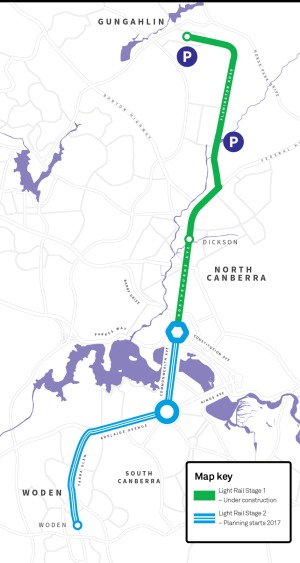 |
| The autonomous car |
Light rail has already started construction
in the first stage of what will be a Canberra wide network. This will transform
our city and change our culture over time, from a car-centric society where
each family needs to have at least two cars, to a place where public transport
is easily accessible, frequent and reliable.
Opponents of better public transport are
largely drawn from the 93% of Canberrans who don’t use it now, and can’t see
why they should have to pay for it. They are used to driving everywhere and
parking at the door for free. That is what it was like when they arrived in
Canberra in the 1970’s and they can’t understand why it needs to change.
Canberra is changing. The Y Plan was of its
time and followed current planning trends, but the NCDC is not a religion and
logic needs to be applied to future planning. Some elements of the Burley
Griffin vision were adopted, others weren’t. Some elements of the Y Plan have
been successful, others not. The current trend of a family home having not one or
two cars, but four or more in the driveway is a trend the Y Plan fostered, that
cannot continue.
Parking is no longer free, and the vast
free car parks of Civic and our Town Centres are no longer there. Free car
parking in the Parliamentary Triangle no longer exists. As our city matures,
those vast spaces are being replaced with buildings that are of greater
economic use than having a car sit on them for eight hours or more a day.
Buses in Canberra once coped admirably with
the task assigned; yet as the Y Plan stretched to Tuggeranong and Gungahlin, a
bus trip became long and circuitous. We asked ACTION to be both a local bus
service and a mass transit provider. It has struggled with this dual task, and
under varying management and union approaches, it has seen patronage trend down
as private car use soars.
At the same time, the intertown routes are
at capacity. On some routes the buses sail past people, as they are full.
Clearly a better approach needs to be adopted, and in 2012 the ALP and Greens
went to an election with light rail as that better approach.
In 2016 light rail
construction has started. Over time a network will link Canberra and encourage
greater public transport use, better planning around transport corridors and
decrease road congestion.
If you could travel in comfort to work
every day, why would you drive? Wouldn’t you rather sit and read, or rest instead
of wait in a traffic jam and then spend fifteen minutes looking for expensive
parking?
Opponents of light rail talk up a bus only
solution, yet it is obvious that more of the same will deliver us, well, more
of the same. More buses wont lead to greater public transport use or encourage
Transit Oriented Development. More buses on the roads wont reduce road
congestion either. Not on Northbourne, and not anywhere else.
They also claim autonomous cars will
suddenly emerge from labs and become the panacea to the private car, and
miraculously reduce the need for mass transit. While this technology may
eventually become practical, it isn’t now and not for the foreseeable future.
Even if it was, it really only replaces one car for another, and a robot car
going home and returning twice a day doubles road congestion instead of
reducing it.
 |
| 14,000 Raiders fan leave Bruce Stadium and have to wait for 14.000 autonomous cars |
The biggest flaw in the self-driving car
dream is what happens when fourteen thousand Raiders fans exit Bruce stadium
after a victory? Or when the Department of Inland Drainage closes down at
5.30PM and eleven hundred employees walk out the door at once? Which person’s
car arrives to pick them up first? Where do they queue?
We replace traffic jams with driverless
traffic jams. Driverless cars are not a mass transit solution. They are a part
of a larger transport picture with multiple solutions to multiple demands.
Light rail offers passenger capacity beyond
current buses, with 220 people able to be carried in a single light rail
vehicle. When light rail service
commences, over a million bus kilometers a year will be freed up to increase
frequency of local bus services.
Your once an hour bus service in Kaleen
could become once every half hour or better. As each light rail stage rolls
out, the integration of bus and light rail becomes better, and service becomes
more frequent and more reliable.
Driverless cars and buses alone cannot
provide these future options. We need to support the politicians that have
invested enormous political capital in our future, by recognising that the
Canberra of the past has changed, and we need to let that change happen in a
planned way.
A version of this article was published in City News on 2 Oct 2016
A version of this article was published in City News on 2 Oct 2016
For more frequent updates on Capital Metro and light rail related news, please visit our Facebook page 'Light Rail for Canberra'.












